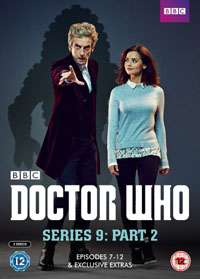DVD Extras for this story on the 14-episode box sets include:
Ballad of MorpheusFirst things first though. I really liked the concept behind the "Morpheus" project, in trying to harness all those lost hours of sleep for extra profit and productivity. That's one of those grand ideas that can withstand a lot of exploration in a science-fiction format. Gatiss has taken a nice crack at it here, in devising a machine, an inventor, and beginning to show both a few things that might go wrong with the process itself, and a few problems with the motives behind the very idea.One of the enjoyably cool additions to the Morpheus concept is their adoption of that old 1950's classic song "Mr. Sandman" by Pat Ballard as their identification logo theme. The sound effects department also gets a full blown outing on this one, as they take over the role of orchestrating the audience's moods, with occasional help from Ballard's song. The plot for this narrative is also nicely strong, as it gives us a lot of good twists and escalations, and has a good feel of mystery behind it. I also like the setting for the adventure, on a space station orbiting Neptune (I really don't think Doctor Who has come here before), with a Human colony on Neptune's moon Triton as a significant part of the backdrop. This is one of the best settings of the season, in fact.
Neptune FootageSo what's eating at this story's ranking? The first of the adventure's big problems is, I think, limiting itself to using "found footage" only throughout its entire running length. There are sections where this style proves worthy, usually whenever attention is being called to it, or it provides a clue to the mystery. But a lot of the time, it just results in crappy cinematography, where it is really difficult to tell who or what one is looking at, much less recognize specific characters and begin to care about them. And it seems there are many points when scares are intended, but totally don't work because of these arbitrary cinematic limits. The debut of the monsters doesn't really work, because it's all too easy to mistake them for members of the rescue team wandering around. At one point the narrative suggests that Rassmussen had been attacked in the previous big scene. What? I totally didn't see that on any of my viewings.I must say though, on my second time through I actually breathed a sigh of relief after Clara's encounter with the Morpheus machine, because suddenly we started getting some really good shots of the Doctor and company investigating the mystery. What bizarre cinematography we get in this one took a quantum leap forward in quality at that point. Ultimately, I think I would have preferred if we could have jumped in and out of "found footage" mode as the adventure played out, with most of the action being shot normally. I mean, we're on a space station orbiting Neptune, so it's not like this adventure is going to have the power of "The Blair Witch Project" in making the audience think this is something that actually happened in front of someone's camera one night. Plus, we miss out on half of the fun of being out at Neptune - all those cool optical shots of planets, moons, and space stations fighting to keep the anti-gravity on to stay above Neptune's atmosphere - all missing to maintain the "found footage" mantra. The setting disappointingly winds up being underused, undeveloped, and undercooked in the end. And normally, I might also suggest just putting the title sequence on right at the front of the episode, without having it try to divide a "hook" from the rest of the story. However, since we currently have a very crappy title since Peter Capaldi debuted in the role, I won't argue with leaving it out entirely. I'd probably have fast-forwarded over it anyway.
Horror UnboundThe second of the major problems here concerns the real point of the adventure, which ropes in the decision to end it where it ends. Most of the other episodes of the season have had some really strong philosophical territory to explore, to which they have devoted significant time and energy, resulting in some powerful drama as they do significant justice to the subject matter. "Sleep No More" on the other hand, seems content just to create some scares and intersperse a bit of levity. This is a big factor in how the other stories of the season rose in the rankings and left this adventure snoozing somewhere behind.And though the ending blasts through a few reversals to pretty much cover all the required answers to the mystery, it doesn't really finish resolving the conflict. The Doctor establishes the goal for himself of going down to the Triton colony to put all the Morpheus machines out of action - a tall order it would seem, considering the likely resistance from all the same people he's trying to help. Additionally, we learn that the "found footage" signal itself is likely just as dangerous and far more difficult to control. Following the pattern of the season so far, all this made me look forward to either a complementary episode or an official "part two" written by Gatiss himself, taking place on the Triton colony (that could look quite cool), following the Doctor and friends tackling these challenges. Behind the scenes, Peter Capaldi was quite aware of the anticipation created for furthering the adventure, and there is also much talk of a sequel happening someday. I was actually quite surprised when I hit "play" on the next episode and discovered that it didn't continue this story with an episode on Triton. The fact that Nagata makes her escape in the TARDIS with the Doctor and Clara at the end kind of insists that the next chapter of this story happens immediately on Triton, where they would be dropping her off. It was most disappointing that the season broke its smart streak of two-parters and paired-episodes here, and sunk back into the rut of quick one-offs. Obviously, ending on the reveal of the most insidious scare yet is intentional, part of the creep factor that Gatiss wants to leave the audience on. My response is just kind of.... Okay, well, I don't care. It makes me look back on the process, and discover its holes and hokiness. How does sleep-dust accumulate to horrific levels and acquire enough intelligence to go stalking about the corridors - as implied in the story's dialogue? The process perhaps didn't get quite enough proper exploration to hit a note of plausibility with me. It had an intriguing start, but didn't end up at "Sandmen" out of any logic other than an obsession with horror. On the extras, we learn that the original idea was that the sandmen were people, only the sleep dust had "overgrown" during their "sleep" until it covered them and transformed them. That would make more sense - but the explanation doesn't quite get into the actual episode that way. I often feel that Mark Gatiss over-writes his episodes and changes too many things as he goes along, whereas sticking with the original inspiration would often yield a better end result. Ending on a note of horror in this case kind of took too much away from the adventure, with the Doctor achieving little more than an escape from the "current batch" of sandmen. On the good side though, the episode didn't feel overly crammed by squeezing too much predictable narrative into a mere 45-minute episode. Instead it feels like we got part one of something that deserved to be at least 50% longer, and then got cheated out of part two. It felt like a similar experience to "Black Orchid" (story no. 121), "The King's Demons" (story no. 129), or even Gatiss's own "Victory of the Daleks" (story no. 210).
International Titles:Deutsch: "Morpheus Arme"Magyar: "Ne Aludj Többé"Français: "Dans les bras de Morphée"Русский: "Не спите больше"Italiano: "Più non dormirai"This story is available on DVD and Blu-ray:
Comments on this article are welcome. You may contact the author from this page:
|
||||||||||||||||||||||||||||













